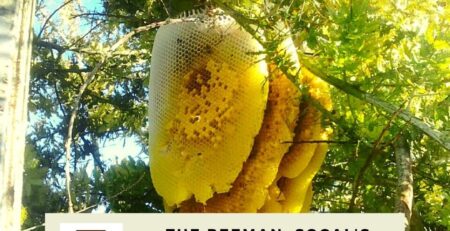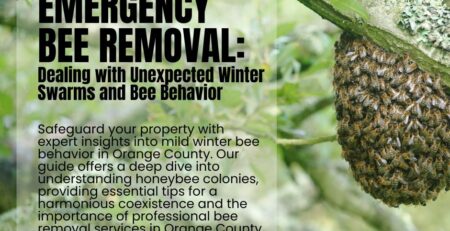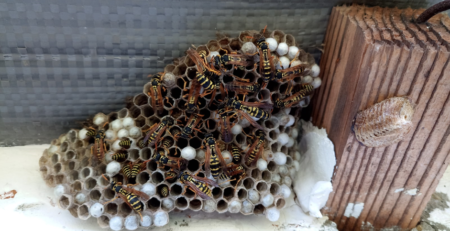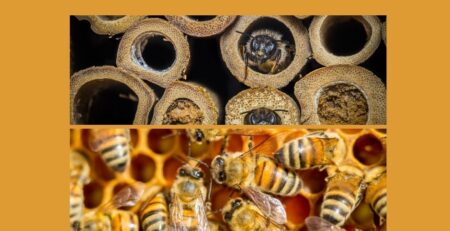Understanding Bee Behavior in Colder Months: A Guide for Orange County Residents
As the temperature drops and the autumn leaves start to fall, it’s essential for Orange County residents to be aware of the changing behavior of bees during the colder months. This knowledge can help you better understand when and why bee infestations may occur and how to approach bee removal in Orange County in a safe and responsible manner.
Reduced Activity Levels:
In the autumn and winter, bees become less active compared to the warmer months. Here’s a closer look at how bees adapt during this season:
Seasonal Slowdown:
With the decrease in temperature, bees experience a natural slowdown in their activities. Unlike the bustling warmer months, bees become less active, adjusting their daily routines to the cooler climate.
Limited Foraging Expeditions:
The scarcity of blooming flowers in Orange County during the autumn and winter prompts bees to reduce their foraging expeditions. Unlike spring and summer, when vibrant blossoms are abundant, the bees are less likely to venture out in search of nectar and pollen.
Hive-Centric Lifestyle:
Bees exhibit a hive-centric lifestyle during the colder months. Rather than exploring the surrounding areas, they tend to stay close to their hives, focusing on internal hive activities and maintenance.
Strategic Clustering:
To combat the chill, bees employ a smart strategy—clustering. By huddling together within the hive, bees generate and conserve heat collectively. This behavior helps them maintain an optimal temperature for the survival of the colony.
What It Means for Bee Removal in Orange County:
Understanding the reduced activity levels of bees during autumn and winter is crucial for effective and safe bee removal in Orange County. Here’s why:
Strategic Timing for Removal:
Given the decreased activity levels, choosing the right time for bee removal becomes pivotal. Opting for removal during periods of minimal activity ensures a safer process for both the removal experts and the bees.
Heightened Defensiveness:
While less active, bees can become more defensive during the colder months. This means that even a seemingly subdued hive may pose challenges during removal, necessitating the expertise of professionals.
Expert Handling Required:
Professional bee removal services in Orange County are equipped to handle the nuances of bee behavior in cooler seasons. Their expertise ensures that removal is conducted efficiently and safely, considering the unique challenges presented by the bees’ reduced activity.
Humane Practices:
Recognizing the bees’ vulnerable state in colder months underscores the importance of employing humane removal practices. Bee removal experts can relocate the colony rather than resorting to extermination, contributing to the preservation of these essential pollinators.
In conclusion, as the autumn breeze sweeps through Orange County, being attuned to the reduced activity levels of bees is key to responsible bee removal. By aligning removal efforts with the natural rhythms of bee behavior, we not only ensure our safety but also contribute to the well-being of these vital contributors to our ecosystem.
Nesting and Reproduction
Bee colonies shift their focus from reproduction to survival during the colder seasons. Here’s why:
Reproductive Priorities in Autumn and Winter:
Bee colonies, like many organisms, adapt their priorities based on seasonal changes. During the colder seasons, the focus shifts from reproductive activities to the survival of the colony. This strategic reallocation of energy and resources is essential for the colony’s resilience in the face of challenging weather conditions.
Queen’s Adjusted Egg-Laying Activities:
At the heart of the colony’s reproductive dynamics is the queen bee. In response to the changing environment, the queen strategically reduces her egg-laying activities. This intentional decrease in egg production leads to a smaller population within the hive.
Impact on Colony Size and Structure:
The reduction in the number of new bees being born during the colder seasons has a direct impact on the overall size and structure of the colony. The population becomes more tightly knit, emphasizing cooperation and unity among the existing members.
Adaptive Measures for Winter Survival:
This shift in focus aligns with the colony’s overarching goal: survival through the winter months. By reducing the population and conserving resources, the bees enhance their chances of weathering the colder temperatures and limited foraging opportunities.
What It Means for Bee Removal in Orange County:
Understanding the nesting and reproductive changes within bee colonies during autumn and winter is crucial for effective and humane bee removal in Orange County. Here’s how this knowledge can guide the removal process:
Smaller Colonies, Different Dynamics:
Bee removal experts should be aware that colonies during the colder seasons are likely to be smaller and exhibit different dynamics compared to the warmer months. This knowledge guides the removal process and ensures a tailored approach.
Timing Considerations for Removal:
Recognizing the queen’s adjusted egg-laying activities highlights the importance of strategic timing for bee removal. Coordinating removal efforts during periods of reduced reproductive activity ensures a more efficient and less disruptive process.
Professional Expertise for Winter Removal:
Given the unique dynamics of bee colonies in colder seasons, seeking professional bee removal services in Orange County becomes even more crucial. Professionals are equipped to navigate the complexities of smaller colonies and understand the behavioral nuances during this time.
Ethical Considerations:
Understanding that bees intentionally cut back on reproduction brings attention to the ethical side of bee removal. Going for removal methods that are kinder, focusing on relocating them instead of extermination, goes in harmony with the way bees naturally adapt to the seasons.
In conclusion, the seasonal shift in nesting and reproduction within bee colonies in Orange County is a testament to their remarkable adaptability. By recognizing and respecting these changes, we can approach bee removal with an understanding that prioritizes both the safety of residents and the well-being of these essential pollinators.
Conserving Resources
Bees, the unsung heroes of our ecosystem, undergo a remarkable shift in behavior to ensure their survival during the colder months. Let’s delve into how they conserve resources with a focus on honey storage and water consumption:
Winter Pantry Preparations:
In the bustling spring and summer months, bees engage in fervent foraging, collecting nectar from blooming flowers. This nectar is transformed into honey—a vital resource for their winter survival. The autumn season witnesses bees diligently storing ample honey reserves within their hives, strategically positioning themselves for the impending colder weather.
Reliance on Honey Reserves:
Come winter, the bees’ primary sustenance lies in the honey reserves they’ve meticulously gathered. Reduced foraging opportunities mean they must rely on these reserves not only for nutrition but also for the energy required to generate warmth within the hive.
Reduced Water Consumption:
Another smart adaptation in their resource management strategy is the reduction in water consumption. Bees understand the delicate balance between hydration and the need to prevent excess condensation within the hive. By minimizing water intake, they mitigate the risk of dampness that could compromise the hive’s structural integrity and the well-being of its inhabitants.
Maintenance of Hive Environment:
Beyond sustenance, honey serves a dual purpose. Bees use it to seal and protect the hive from the elements. The insulating properties of honey help maintain a stable temperature within the hive, shielding the colony from the harsh external conditions.
What It Means for Bee Removal in Orange County:
Understanding the meticulous resource management strategies of bees during winter provides valuable insights for bee removal in Orange County. Here’s how this knowledge can guide the removal process:
Respect for Honey Reserves:
Bee removal efforts should be approached with a deep respect for the honey reserves that sustain the colony. Professionals must take care not to disrupt these crucial food stores, ensuring the well-being of the bees during and after the removal process.
Timing Considerations:
Recognizing the reliance on honey reserves emphasizes the importance of strategic timing for bee removal. Coordinating removal efforts during periods when the colony’s honey stores are less critical ensures a smoother process with minimal impact on their winter survival.
Awareness of Water Management:
Bee removal experts should be cognizant of the bees’ reduced water consumption and the role it plays in preventing excess condensation. This awareness guides the removal process to minimize disturbances to the hive environment.
Preservation of Hive Structure:
The protective role of honey in maintaining the hive’s structural integrity underscores the need for gentle removal practices. Preservation of the hive structure ensures that bees, even after removal, have a conducive environment for winter survival.
In conclusion, the strategic resource management of bees during winter reflects their incredible adaptability. By understanding and respecting these conservation efforts, bee removal in Orange County can be approached with a mindful and informed perspective, ensuring the well-being of both residents and the vital pollinators that contribute to the region’s biodiversity.
Protective Behavior
Bees, in their innate wisdom, become more vigilant and defensive during the colder months. Understanding this heightened defensiveness is pivotal for anyone considering or involved in bee removal in Orange County. Let’s delve deeper below:
Scarcity Breeds Defensiveness:
The colder months bring with them a scarcity of resources, from dwindling floral sources to reduced foraging opportunities. Faced with these challenges, bees adopt a more defensive stance to safeguard their hive and the precious food stores they’ve amassed.
Smaller Population, Greater Defense:
With a smaller population due to reduced reproductive activities, each individual bee plays a more critical role in the survival of the colony. This smaller but fiercely protective group acts as a united front, responding swiftly and decisively to perceived threats.
Prioritizing Hive Protection:
The winter season places a premium on hive protection. Bees channel their energy towards fortifying the hive against potential intruders, be they other insects, animals, or even well-intentioned humans attempting removal.
Challenging Bee Removal Scenarios:
The combination of reduced resources, a smaller population, and heightened defensiveness can make bee removal in the winter more challenging. Bees may react more aggressively to perceived threats, posing potential dangers during removal efforts.
What It Means for Bee Removal in Orange County:
Understanding the protective behavior of bees during the colder months is crucial for safe and effective bee removal in Orange County. Here’s how this knowledge can guide the removal process:
Professional Expertise is Essential:
Given the increased defensiveness, relying on professional bee removal services in Orange County becomes paramount. Professionals possess the experience and knowledge to navigate defensive behaviors, ensuring the safety of both residents and the removal team.
Strategic Timing for Removal:
Recognizing the bees’ defensive posture underscores the importance of strategic timing for removal. Coordinating removal efforts during periods of minimal activity, when defensiveness is likely to be less pronounced, minimizes risks and challenges.
Protective Gear and Techniques:
Bee removal experts must employ specialized protective gear and techniques tailored to handle defensive behaviors. This includes using smoke to calm the bees and employing methods that prioritize the safety of all involved parties.
Ethical Considerations:
Acknowledging the bees’ defensiveness emphasizes the ethical considerations in bee removal. Opting for humane removal methods that prioritize the well-being of the bees aligns with the natural instincts driving their protective behavior.
In conclusion, the protective behavior exhibited by Orange County bee colonies during the colder months is a testament to their resilience and commitment to survival. By approaching bee removal with an understanding of this defensiveness, we can ensure a harmonious coexistence that prioritizes the safety of residents and the vital role bees play in our ecosystem.
Swarming Behavior
As the fall breeze sweeps through Orange County, the natural world undergoes a subtle yet significant transformation, marked by the intriguing phenomenon of swarming behavior in bees. While more commonly associated with spring and early summer, swarming can still occur in the colder months, underscoring the importance of vigilance and prompt action in addressing these captivating yet potentially challenging events.
The Instinct to Swarm:
Swarming is a natural and instinctive behavior among bees, driven by the colony’s need to reproduce and find a new nesting site. Even in the autumn of Orange County, bees may embark on this collective journey, creating a spectacle that demands attention and understanding.
Unpredictability of Swarming:
While swarming is traditionally associated with warmer seasons, the unpredictability of nature means it can also manifest in the fall. This unpredictability necessitates vigilance on the part of Orange County residents, beekeepers, and removal services alike.
Search for a New Nesting Site:
Swarming occurs as a colony splits into two groups: one remains in the original hive, while the other seeks a new nesting site. This swarming group, often characterized by a cloud of bees in flight, is on a mission to establish a new home, presenting unique challenges for those in its path.
Importance of Prompt Addressing:
Addressing swarms promptly is crucial to mitigate potential risks and challenges associated with their presence. The urgency stems from the need to guide the swarming bees to a suitable location, preventing them from establishing nests in undesirable or unsafe locations.
What It Means for Bee Removal in Orange County:
Understanding swarming behavior in Orange County provides valuable insights for effective and timely bee removal. Here’s how this knowledge can guide the removal process:
Timely Intervention for Swarm Guidance:
The unpredictability of swarming in the fall emphasizes the need for timely intervention. Bee removal experts should be equipped to assess and guide swarming bees to suitable nesting sites, ensuring the safety of both the bees and the community.
Professional Expertise in Swarm Handling:
Handling swarms requires a specialized skill set and understanding of bee behavior. Professional bee removal services in Orange County bring the necessary expertise to navigate swarming situations, guiding bees to locations that are compatible with human and environmental safety.
Community Awareness and Collaboration:
Community awareness plays a pivotal role in addressing swarming behavior. Educating residents about the possibility of fall swarms encourages vigilance and prompts timely reporting, fostering collaboration between the community and removal services.
Humane Practices in Swarm Management:
Approaching swarming events with a commitment to humane practices ensures the well-being of the bees. Removal methods should prioritize guiding the swarm to suitable locations rather than resorting to extermination.
In conclusion, the occurrence of swarming behavior in Orange County during the fall adds a dynamic element to the region’s ecological tapestry. By approaching these events with understanding, vigilance, and prompt action, we can ensure a harmonious coexistence with these fascinating pollinators.
Choosing The Bee Man: Your Trusted Partner in Orange County Bee Removal
As Orange County embraces cooler times, the bees, crucial pollinators, change up their routines. Dealing with bee removal challenges in fall and winter means understanding these seasonal variations. In the intricate dance between human and bee environments, the choice of a removal service is crucial. The Bee Man stands out as your reliable partner in Orange County bee removal. What makes them stand out?
Expertise: The Bee Man brings a wealth of experience and knowledge, ensuring efficient, humane, and safe removal practices.
Professionalism: With a keen understanding of seasonal nuances and bee behavior, The Bee Man’s team navigates challenges with precision, prioritizing safety and ethical practices.
Timely Intervention: The Bee Man recognizes the importance of swift action, especially during swarming events, providing timely guidance to ensure the well-being of both bees and the community.
In the delicate balance between coexistence and removal, The Bee Man emerges as the choice company for Orange County residents seeking a harmonious resolution to their bee-related concerns. With The Bee Man, your journey to a pest-free living environment and the preservation of vital pollinators begins with expertise, professionalism, and a commitment to ethical practices.
As you embrace the choice of The Bee Man for a pest-free living environment and the preservation of essential pollinators, the journey continues into another realm of coexistence with our buzzing friends. Transitioning from the delicate balance between coexistence and removal, let’s explore how Orange County residents can actively contribute to the well-being of local bee populations during the colder months through “Bee-Friendly Gardening in Winter.” Here, we’ll delve into practical tips and strategies for cultivating gardens that not only thrive during winter but also serve as nourishing havens for bees, creating a synergy between human habitats and the natural world. Here are some tips to help you create a bee-friendly environment in your garden this winter:
Bee-Friendly Gardening in Winter Tips During Winter
Select Winter-Blooming Plants:
Choose plants that bloom during the winter months to provide a vital food source for bees. Flowers such as winter heath (Erica carnea), pansies, and calendulas can offer nectar and pollen, sustaining bee colonies during times of reduced foraging opportunities.
Provide Sheltered Spaces:
Create sheltered areas in your garden where bees can find refuge from the winter chill. Consider adding bee houses or leaving undisturbed leaf piles in a corner, offering a cozy haven for solitary bees. These spaces contribute to the overall health and resilience of local bee populations.
Maintain a Water Source:
Even in winter, bees need access to water. Set up shallow containers with fresh water and add pebbles or rocks to provide landing spots for bees. This ensures they stay hydrated and helps prevent dehydration during drier winter days.
Avoid Chemical Pesticides:
Opt for natural alternatives or integrated pest management strategies that minimize the use of chemical pesticides. Bees can be more vulnerable during the winter, and reducing exposure to harmful chemicals in the garden promotes their well-being.
Strategic Planting for Windbreaks:
Orange County can experience brisk winter winds. Planting windbreaks, such as evergreen shrubs or trees, not only protects your garden but also provides a more favorable environment for bees. These windbreaks can create microclimates, making it easier for bees to forage and maintain hive temperatures.
Leave Some Garden Cleanup for Spring:
While tidying up the garden is a common winter practice, consider leaving some areas undisturbed until spring. Hollow stems and fallen leaves can provide overwintering habitats for bees and other beneficial insects. This approach aligns with a more natural and bee-friendly gardening philosophy.
Educate Your Community:
Share your knowledge and passion for bee-friendly gardening with neighbors and friends. Encourage them to adopt similar practices, creating a network of bee-friendly gardens that collectively contribute to a healthier environment for bees in Orange County.
Participate in Citizen Science Projects:
Join local initiatives or citizen science projects focused on monitoring bee populations. This involvement not only provides valuable data for researchers but also fosters a sense of community engagement in safeguarding the well-being of bees.
By incorporating these practices into your winter gardening routine, you not only enhance the beauty of your outdoor space but also play an active role in preserving and promoting the health of the local bee populations in Orange County. Bee-friendly gardens are not only a gift to nature but also a testament to the coexistence between our living spaces and the vital pollinators that contribute to the vibrancy of our ecosystem.
Conclusion
In conclusion, from understanding bee behavior in colder months to embracing bee-friendly practices in your garden, this guide shows the delicate balance between coexistence and responsible management. The Bee Man stands as your trusted partner in Orange County bee removal, offering expertise, professionalism, and ethical practices. As the autumn breeze settles and the bees adapt to cooler times, your journey continues with “Bee-Friendly Gardening in Winter.” By implementing these tips, Orange County residents can actively contribute to the well-being of local bee populations, fostering a harmonious synergy between human habitats and the natural world. Let your garden be a testament to the coexistence of beauty, functionality, and the essential pollinators that grace our ecosystem.











